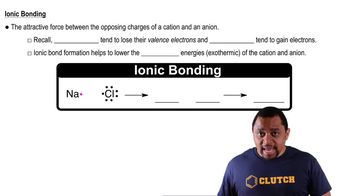Here are the essential concepts you must grasp in order to answer the question correctly.
Ionic Bonding
Ionic bonding occurs when atoms transfer electrons to achieve full outer electron shells, resulting in the formation of charged ions. Typically, metals lose electrons to become positively charged cations, while nonmetals gain electrons to become negatively charged anions. The electrostatic attraction between these oppositely charged ions forms the ionic compound.
Recommended video:
Valency
Valency refers to the ability of an atom to bond with other atoms, determined by the number of electrons in its outer shell. For aluminum (Al), which has a valency of +3, it can lose three electrons, while fluorine (F), with a valency of -1, can gain one electron. Understanding valency is crucial for predicting the ratios of ions in an ionic compound.
Recommended video:
Transition Metals Valence Electrons
Chemical Formula
A chemical formula represents the types and numbers of atoms in a compound. In ionic compounds, the formula is derived from the charges of the ions involved. For aluminum and fluorine, the formula is determined by balancing the total positive and negative charges, leading to the formula AlF3, indicating one aluminum ion and three fluoride ions.
Recommended video:




